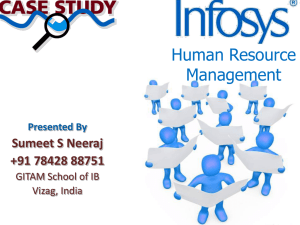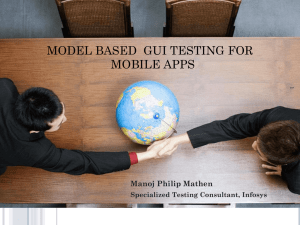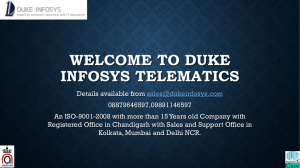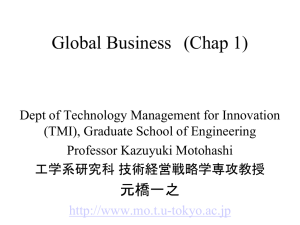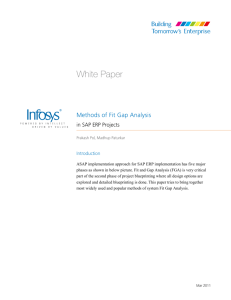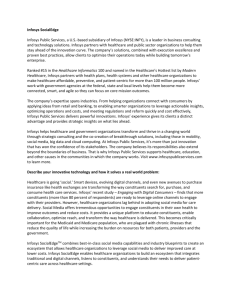Pragmatic Approach to Knowledge Management
advertisement
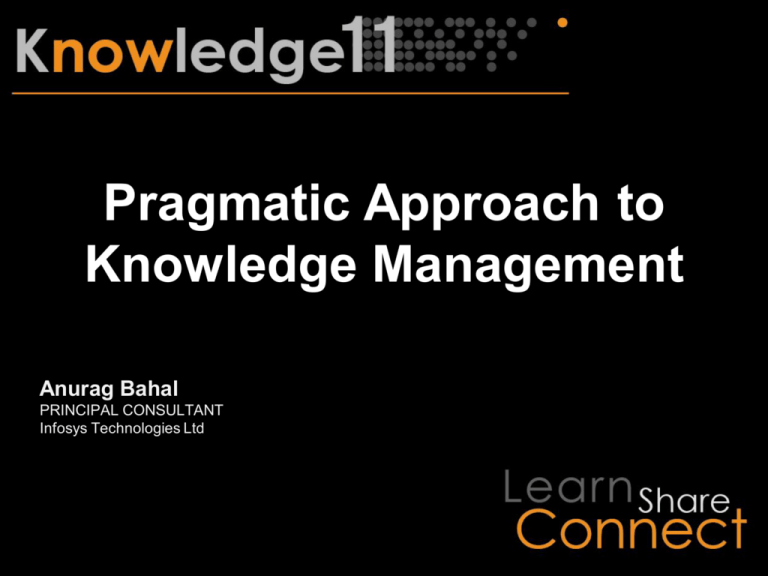
Pragmatic Approach to Knowledge Management Anurag Bahal PRINCIPAL CONSULTANT Infosys Technologies Ltd Evolution of IT in future Statistics are not encouraging “There is substantial opportunity for most companies to improve how they manage and use technology. One of the most consistent and striking conclusion from Business Research of 330 US Public Companies, is that Best Practices are far from Universal, even when they are widely acknowledged as “Best” Many companies are struggling to be effective in technology governance though there is evidence that good technology governance improves performance”. Digitization is not a great equalizer that drives all companies towards similar processes and outcomes. Instead it’s driving the leaders and laggards further apart. Recent Report published by Dr. Andrew Mcafee and Dr. Erik Brynjolfsson from MIT Center of Digital Business and MIT Sloan respectively. Reference WSJ – 04/25/2011 Agenda Knowledge Enigma Knowledge Management Definition Knowledge Management Strategy Implementation Approach Challenges & Lessons Learned Critical Success Factors Case Study KNOWLEDGE ENIGMA Pain Areas Impact • Knowledge exists in pockets • Extended Incident but is not accessible by all Resolution Time • Multiple, Disconnected and disparate repositories • Limited Knowledge Transfer • Limited Knowledge Capture • Limited Ownership - resides in vendor databases • Minimal tracking, and recognition of knowledge • Limited first call resolution • Negative customer perception • Inconsistent and suboptimal execution of processes • Limited Self Service Capabilities • Reduced Productivity Solution • Pragmatic Knowledge Management based on Industry Best Practices • Standardized and Federated Tool Sets • Concerted Effort with defined Milestones over a 3 Year Roadmap • Articulated Measures of Success • Knowledge Management is typically displayed within the Data–to–Information–to–Knowledge–to–Wisdom (DIKW) structure. There are Key Knowledge Management activities around each element of this structure. • We need to create the enterprise-wide ability to effectively transition useful data and information into critical knowledge to ensure service stability, maintainability, and performance that lends itself to Organization wisdom. KNOWLEDGE MANAGEMENT The purpose of Knowledge Management is to ensure that the right information is delivered to the appropriate place or competent person at the right time to enable informed decision making. Information Technology Infrastructure Library (ITIL) 3 Spheres of Knowledge Management TECHNOLOGY KM Processes - Technology Provides a secure central space where employees, customers, partners & suppliers exchange information, share knowledge and guide each other and the organization to better decisions. This could be in the form of knowledge-portal on the corporate intranet or a centralized repository which allows the team members to use and share information. ANALYZE CREATE OBSERVE MAINTAIN KNOWLEDGE ORGANISATION REFINE DISSEMINATE People - The biggest challenge in Knowledge Management is to ensure participation by all the team members in knowledge sharing, collaboration and reuse to achieve business results. This is achieved by making small changes in the culture through combination of trainings, motivation/recognition & rewards etc. * Source - Infosys KShop These include standard processes for knowledgecontribution, content management, retrieval, membership on communities of practice, implementationprojects based on knowledge-reuse, methodology and standard formats to document bestpractices & case studies, etc. Evolution of Knowledge from Data “Knowledge, not information, leads to a competitive advantage in business.” Nonalgorithmic M a t u r i t y Nonprogrammable WISDOM Knowledge is derived from information in the same way information is derived from data; it is a person‟s range of information. KNOWLEDGE INFORMATION Information: Aggregation of data that makes decision making easier. DATA Algorithmic Wisdom: a state of the human mind characterized by profound understanding and deep insight. It is often, but not necessarily, accompanied by extensive formal knowledge. Programmable From Data Processing to Knowledge-based Systems Data: Unorganized and unprocessed facts; a set of discrete facts about events. Key Terms Information Knowledge Knowledge Management Service Knowledge Management System Information assets are collections, patterns, and meaningful representation of data applied in Organization contexts such as customers, contracts, services, projects and operations. They are useful for various purposes including communication, coordination and control of business activities. Information assets exist in various forms such as documents, messages, records. Examples are Business Acquisition Report, Server Migration Reports, etc. Knowledge assets are accumulations of awareness, experience, insight and intellectual property that are associated with Organization operations. Management, Organization, People and Process type of assets use and store knowledge assets. Examples - Information Security Program Standard, Known Error Record, Business Capabilities, Performance Expectations, Stakeholders and Resources list - etc. Knowledge is dynamic and context based. Knowledge puts information into an „ease of use‟ form, which can facilitate decision making. The Process responsible for gathering, analyzing, storing and sharing knowledge and information within an Organization. The primary purpose of Knowledge Management is to improve Efficiency by reducing the need to rediscover knowledge. A set of tools and databases that are used to manage knowledge and information. The SKMS includes the Configuration Management System, as well as other tools and databases. The SKMS stores, manages, updates, and presents all information that an IT Service Provider needs to manage the full Lifecycle of IT Services. Source – Derived from ITIL, Six Sigma and Consortium for Service Innovation Artifacts. Knowledge based on Information Hierarchy Strategic Knowledge Tactical Knowledge Immediate Attention Operational Knowledge Information Hierarchy • Benchmarking and Advanced Analytics - At the apex of the information heap is the need to understand the effects of our operational decisions and more importantly how we stack up regarding our ability to deliver cost effective quality solutions/services to the business • Service Value - In the middle are the many ways we manage and ensure service value. This can be in vendors performance, Organization process performance, regulatory compliance, and security assurance to name a few. • Operational effectiveness- At the bottom our informational stack are taps into the core data which help us understand how well we are managing service performance, compliance and overall IT Operational effectiveness. Characteristics of Knowledge Assets There is a foot print that enables tracking and traceability of every stage of Asset Lifecycle. e.g. There is a paper trail of approval and review in Knowledge Management database, etc. Integrity Traceability Ensures Knowledge Assets are following secure principles and the elements of the assets are updated as per data integrity and change management principles. e.g. KEDB is updated with frequently occurring incidents by a authorized process, etc. Availability Knowledge Asset Constructs Each Asset must deliver value that is clear to management and the organization. Achieved value is significant, visible and can be translated to financial benefits of cost, reduced risk or revenue/cash. e.g. Standards to Exception mapping, etc. Measurable Knowledge Assets are Available for deployment for Business Value. This implies that Assets are usable and are accessible when needed by customers. This includes Interoperability of Assets e.g. Knowledge on Change Management is shared and is usable for Release Management. Repeatability Assets are created and maintained in a manner that is following a standard approach that is extendable for new assets and it is repeatable over time, business units and geographies. KNOWLEDGE STRATEGY What comprises a knowledge strategy? Vision coupled to Strategic Objectives Clearly defined term for “knowledge” – specific to organization‟s context Technology : A Service Knowledge Management System Knowledge Lifecycle – creation, update, publication and archival of knowledge Knowledge Governance – roles, metrics, training Knowledge culture Knowledge Strategies In the past, companies adopted one of 3 possible strategies. However, today only two, numbers 2 and 3 in the list below, are viable. 1. Reckless negligence. This strategy involves continuing with business as usual: doing little or nothing to improve the capabilities in information, data, and knowledge management, assuming that we can cut corners and shave costs without reprisal. Perhaps 25 to 30 percent of the companies in the world have chosen this strategy. 2. Knowledge Competence. The goal here is to be an efficient and effective company with just enough emphasis on responsible management of the Knowledge. These are the characteristics of this Strategy: 3. – The Key People, Process and Tools capabilities have to be sufficiently developed to substantially reduce operational inefficiency, but they do not have to be world-class . Under this strategy, the Knowledge is not the center of the business. – Focus on delivering quality products and services to customers and shareholders through better knowledge. – Comply with regulations and make adequate investments in building the capabilities for information, data, and knowledge management as well as investing in Organization communication. – Perhaps 50 percent of the companies in the world fall into this category. Typical examples are Consumer products companies like Safeway, Unilever and Financial Services Companies like Barclays. Knowledge as a competitive advantage. This strategy is often adopted by companies that are in the Knowledge Intensive Industries or companies that want to up the ante in the spirit of continuous improvement. These are the Key characteristics of this Strategy: – This Strategy involves making Knowledge Management a critical capability of the organization. – This capability distinguishes the company from the competition, attracts both employees and customers, and can earn an enviable reputation among customers, investors, regulators, suppliers, and policymakers. – Being a Knowledge-driven company is a painstaking and high investment endeavor, in which you pay as much attention to incorporating effective Knowledge Practices in the Ongoing Business as to developing the next great product. – Perhaps 20 percent of the companies in the world fall into this category. Typical examples are Companies renowned for innovation like 3M, Apple and Companies that are in Knowledge Business like Mckinsey, Booz & Co. and Accenture. Source – Infosys KM Practice Knowledge Lifecycle Source : Industry Frameworks like ITIL, Six Sigma and TOGAF Start of the Asset Lifecycle • Continuous improvement in alignment with business objectives • Add detail to the process and continue to evaluate that the controls are worth implementing Ongoing Governance • Activities pertaining to monitor review, control, and correction of Asset practices • Capability Reviews • Templates and detailed guidance on implementing controls Evolution Process Asset Enforcement Process Asset Definition Process • The set of processes that define the Knowledge Asset or Artifact for the enterprise • Composed of Planning , Research and Approval Processes Asset Rollout Process • The set of processes for facilitating adoption of Knowledge Management across the organization • The key processes include Collection, Communication, consulting, knowledge management, Change Management and training. CASE STUDY The Help Desk at a large Financial Services organization faced the following challenges: – – – – Low User satisfaction Large call volumes Phone primarily used by users to contact Help desk, leading to more cost of operations Poor knowledge management leading to no service improvement Scope – – – Assess the knowledge and knowledge management practice Utilize Service-now platform as a medium for self- service and knowledge management Define the knowledge management lifecycle, workflow and roles Approach – – – – Demonstrate tangible benefits for the organization by piloting KM in a niche, but highly visible domain of Help Desk. Deploy KM process through workflows, roles and responsibilities, governance mechanisms, templates and metrics. Prepare the organization for the adoption the knowledge management culture through communication and positioning knowledge as an integrator of all processes. Leveraged Service-now as a medium of deploying the KM process. Demonstrate tangible benefits for the organization by piloting KM for Help Desk Purpose – – – Showcase tangible benefits by implementing basic Knowledge Management (ie a simple knowledge repository and knowledge lifecycle). Secure executive sponsorship for KM strategy adoption Explore and understand the potential of the Service-now as a platform for enterprise wide knowledge management Method – – – – – Step 1: Analyzed the current call volumes and the cost associated with resolving the issues at various levels (level 1, 2 & 3). Step 2: Recognize patterns and trends for the most frequently received calls/incidents. Step 3: Utilize Service-now as a platform to create a knowledge repository with knowledge cases for the most frequently received calls/incidents and make the repository available to the Service Desk agents. Future step : Promote the knowledge cases as a self help for end users to refer to before approaching the Service Desk. Step 4: Present the benefits realized due to the above KM pilot : Benefit realized in terms of the reduced cost due to reduced call volumes. (Please note these are only tangible benefits. Intangibles like improved efficiency of Service Desk also would also follow) Deploy KM process through workflows, roles and responsibilities, governance mechanisms, templates and metrics Purpose – – Define a knowledge management process so as to capture the knowledge across the organization in a form that can be easily applied. Make implicit knowledge explicit Components Design aspects • • • Knowledge Lifecycle – knowledge capture, storage, search, retrieval and update. Integrates with Service Management processes across organization Governance mechanism for the knowledge generated and stored in the service-now database Technical / Operational aspects of KM process • • • • • Define workflow for knowledge capture, storage, retrieval and update Define roles and responsibilities for Knowledge Management process – who can create, publish , reject and update cases Define templates and structure for the knowledge cases Define the gating criteria and visibility model for knowledge cases Identify and define feedback capture mechanism for knowledge cases • Metrics to measure the effectiveness of the KM process Prepare the organization for the knowledge culture Purpose – – – Drive the adoption of the knowledge management process Capture, re-use, feedback and updation of knowledge becomes integral part of customer interaction and service management processes Knowledge Management becomes the integrator between different business units/teams within organization • In essence, Ensure success of KM strategy Methodology: – – – – – Senior Leadership involvement in championing the Knowledge Management cause Identify training needs for Knowledge management and train the Service Desk agents on the use of the tool and the knowledge lifecycle Change definition of “hero” – one who knows and shares it with entire team Recognize individuals and teams contributing the most (quality and quantity) to the capture, storage, application of knowledge Establish Knowledge champions to sustain the knowledge sharing culture across the team/organization SERVICE-NOW.COM AS THE LAUNCH PAD FOR KNOWLEDGE Following features, helped accelerated launch of knowledge Workflow Engine: To deploy the Knowledge management process through the define knowledge lifecycle (creation, storage, publication, search , retrieval and update) Deploy the gating criteria and visibility model for knowledge cases Import set / Export set Import the knowledge articles/cases from legacy database into Service-now knowledge base Approximately 800 knowledge cases migrated Content Management To develop portal for self service for the end users. Portal powered by the search engine and knowledge cases imported Identify and define feedback capture mechanism for knowledge cases Knowledge Base application Develop the template and form for the submission, validation and publication of knowledge by knowledge team Report Generation Easy to configure real time metrics to report the knowledge management process effectiveness and efficiency Metrics to measure the age, utilization and the feedback from end users on knowledge cases SNAPSHOTS FROM SERVICE-NOW.COM End User view of a knowledge case Knowledge Portal CHALLENGES Journey to adopt KM is not easy Why do we need a KM Strategy? Knowledge is too intangible to be captured What is ROI? Knowledge Management viewed and executed in silo, and not viewed as process integrator A culture that encourages hoarding of knowledge, not sharing it with peers CRITICAL SUCCESS FACTORS 1 Knowledge Strategy that identifies the vision, business goals, stakeholders, and activities to be accomplished. 2 8 Detailed Planning that Executive sponsorship will be incorporates activities, schedules, milestones, risk management, and the appropriate monitoring and tracking tools to support success. 7 Integration of Knowledge sharing into normal activities so it doesn‟t appear as a burden, but rather as an enabler. Strategy Executive Leadership Enablement Relevance 3 User’s understanding and commitment to use the knowledge environment. A critical mass of users who are willing to share, contribute, and use what is available must be established for the potential of the environment to be realized. 6 Ongoing training and support will be necessary to both establish the critical mass of users and to ensure the continued understanding and effective use of the environment as it evolves. essential to establishing this knowledge sharing environment. The cultural changes necessary to shift to a sharing environment must be actively supported and fostered throughout the organization by executive team. 5 Technical infrastructure must support sharing from both a cost and architectural standpoint. 4 Motivation and reward systems will need to be created to inspire people to contribute to and use the knowledge environment. Lessons Learnt Small, but decisive steps at a time: Demonstrate tangible benefits for the organization by piloting KM in a niche, but highly visible domain ex Customer Service/Service Desk. Institutionalize KM process and infrastructure as the “integrator” for all processes. Leverage Service-now as a medium of deploying the KM process. Prepare the organization for the adopting the knowledge management culture through communication and enabling people. Knowledge Management credentials Infosys has a comprehensive Knowledge Management infrastructure complete with a dedicated team, a fully functional technical infrastructure and, most importantly, increasing awareness of the criticality of knowledge sharing amongst all employees. Infosys has a fully functional Knowledge Management portal (K-Shop) which acts as the central repository around which all KnowledgeSharing initiatives are built. The KM portal allows for on-line search and sharing of content thereby providing an integrated access solution spanning across the corporate intranet. As Infosys executes projects for its customers, apart from the standard documents (like requirements, programs specifications, test plans), Infosys team is actively encouraged to create and share knowledge, while protecting client confidentiality and IPR. Body of Knowledge – Infosys as a part of project closure dictates that all project teams to publish their experiences as part of our internal KM initiative. It is meant to be a central repository of experiential knowledge that can be tapped by the rest of the team. Many process improvements have resulted primarily because of the above. Infosys has won the prestigious Global Most Admired Knowledge Enterprises (MAKE) Award. A panel of Global Fortune 500 senior executives and internationally-recognized knowledge management experts chose the Global MAKE Winners. The annual Global MAKE study is an international benchmark for KM practices. Infosys is the only company founded and headquartered in India which has been named among the Global Most Admired Knowledge Enterprises. 24 Internal Thank You Principal Consultant Consultant Anurag Bahal Infosys Technologies Ltd Balachandra Emani Infosys Technologies Ltd Anurag_bahal@infosys.com Balachandra_emani@infosys.com
